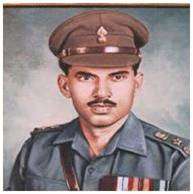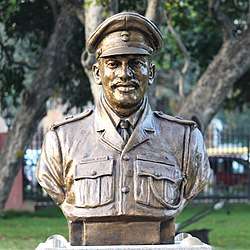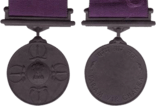Hoshiar Singh Dahiya
Colonel Hoshiar Singh Dahiya, PVC (5 May 1937 – 6 December 1998) was an officer of the Indian Army who was awarded India's highest military honour, the Param Vir Chakra during Indo-Pakistani war of 1971.
Hoshiar Singh | |
|---|---|
 | |
| Birth name | Hoshiar Singh Dahiya |
| Born | 5 May 1936[2] Sisana,[3] Rohtak District, Punjab Province, British India (now in Sonipat District, Haryana, India) |
| Died | 6 December 1998 (aged 61) Jaipur, Rajasthan, India |
| Allegiance | |
| Service/ | |
| Years of service | 1963-1988[4] |
| Rank | |
| Unit | The Grenadiers |
| Commands held | 3 Grenadiers |
| Battles/wars | Indo-Pakistan war of 1965 Indo-Pakistani war of 1971 Battle of Basantar |
| Awards | |
Early life
He was born in Sisana village, Sonipat district, Haryana to Choudhary Hira Singh. After his schooling and one year's study at the Jat College, Rohtak, he joined the Army.[5] He was married to Dhano Devi, who is still alive as of March 2019.[6] He was commissioned in The Grenadiers Regiment of the Indian Army on 30 June 1963,[5][7] and was promoted lieutenant on 30 June 1965.[8]
His first posting was in NEFA. In the 1965 Indo-Pakistan war, he saw some action in the Rajasthan sector,[9] for which he was mentioned in despatches.[10] He was promoted to captain on 30 June 1969.[11]
Honoured with Param Vir Chakra
During the Indo-Pakistani war of 1971, the 3rd Grenadiers was given the task of establishing a bridgehead across the Basantar River in the Shakargarh Sector from 15–17 December 1971. The river was covered with deep minefields on both sides and protected by well-fortified defence by the Pakistani army. Major Hoshiar Singh, commander 'C' Company, was ordered to capture the Pakistani locality of Jarpal. The Pakistani Army reacted and put in sharp counterattacks. Major Hoshiar Singh went from trench to trench, motivating his command and encouraging his men to stand fast and fight as a result his company repulsed all the attacks inflicting heavy casualties on the Pakistani army.[9] Though seriously wounded, Major Hoshiar Singh refused to be evacuated till ceasefire. Throughout this operation, Major Hoshiar Singh displayed most conspicuous gallantry, indomitable fighting spirit and leadership in the highest traditions of the Army. He was awarded the Param Vir Chakra for his bravery and leadership. He was also Mentioned-in-Despatches.[5]
Param Vir Chakra Citation
The Param Vir Chakra citation on the Official Indian Army Website reads as follows:
CITATION
MAJOR HOSHIAR SINGH
3 GRENADIERS (IC-14608)On 15 December 1971 a battalion of the Grenadiers was given the task of establishing a bridgehead across the Basantar river in the Shakargarh Sector. Major Hoshiar Singh was commanding the left forward company and he was ordered to capture the enemy locality of Jarpal. This was a well-fortified position and was held in strength by the enemy. During the assault, his company came under intense shelling and effective crossfire from enemy medium machine guns. Undeterred, he led the charge and captured the objective after a fierce hand-to hand fight. The enemy reacted and put in three counter attacks on 16 December 1971, two of them supported by armour, Major Hoshiar Singh unmindful of the heavy shelling and tank fire went from trench to trench, motivating his command and encouraging his men to stand fast and fight. Inspired by his courage and dauntless leadership, his company repulsed all the attacks inflicting heavy casualties on the enemy. Again, on 17 December 1971 the enemy made another attack with a battalion supported by heavy artillery fire. Though seriously wounded by enemy shelling, Major Hoshiar Singh again went from trench to trench moving about in the open with utter disregard to his personal safety when an enemy shell landed near the medium machine gun post injuring the crew and rendering it inoperative. Major Hoshiar Singh, realizing the importance of machine-gun fire, immediately rushed to the machine-gun pit and though seriously wounded himself, manned the gun inflicting heavy casualties on the enemy. The attack was successfully repulsed and the enemy retreated leaving behind 85 dead including their Commanding Officer and three other officers. Though seriously wounded, Major Hoshiar Singh refused to be evacuated till the ceasefire.
Throughout this operation, Major Hoshiar Singh displayed most conspicuous gallantry, indomitable fighting spirit and leadership in the highest traditions of the Army.[5]
Later career
Singh was promoted to substantive major on 30 June 1976,[12] subsequently serving for two years as an instructor at the Indian Military Academy, Dehradun. Promoted to lieutenant-colonel on 8 April 1983,[13] he eventually rose to command of his battalion. He retired in May 1988 with the rank of colonel and settled in Jaipur, but frequently visited his village of Sisana and successfully encouraged many local residents to join the armed forces.[4] He succumbed to a cardiac arrest on 6 December 1998, aged 61, and was cremated with full military honours at Jaipur. He was survived by three sons, two of whom followed their father into the army as commissioned officers in the Grenadiers, with one joining the 3rd Grenadiers.[4]
In popular culture

Mohanlal reprised Major Hoshiar Singh's character as Major Sahadevan in the 2017 Malayalam film, 1971: Beyond Borders.[14]
See also
References
- @KSBSectt (7 May 2018). "Col. Hoshiar Singh Dahiya" (Tweet) – via Twitter.
- "Param Vir Chakra winners since 1950". The Times of India. 25 January 2008. Archived from the original on 11 April 2016. Retrieved 11 April 2016.
- "Bravery award winners honoured". The Tribune (Chandigarh). 18 May 2010. Archived from the original on 11 April 2016. Retrieved 11 April 2016.
- "Dauntless leadership in the face of enemy". The Tribune (Haryana). 12 May 2018. Retrieved 30 June 2019.
- The Param Vir Chakra Winners (PVC), Official Website of the Indian Army, retrieved 28 August 2014 "Profile" and "Citation" tabs.
- A date with war heroes, The Tribune, 15 Mar 2019.
- "Part I-Section 4: Ministry of Defence (Army Branch)". The Gazette of India. 11 December 1965. p. 655.
- "Part I-Section 4: Ministry of Defence (Army Branch)". The Gazette of India. 4 June 1966. p. 330.
- "Here Are 12 Untold Stories Of Martyrs Who Sacrificed Their Lives In 1971 Indo-Pak War". indiatimes.com. 16 December 2016. Retrieved 24 November 2018.
- "Part I-Section 1". The Gazette of India. 5 November 1966. p. 733.
- "Part I-Section 4: Ministry of Defence (Army Branch)". The Gazette of India. 13 December 1969. p. 1219.
- "Part I-Section 4: Ministry of Defence (Army Branch)". The Gazette of India. 8 January 1977. p. 39.
- "Part I-Section 4: Ministry of Defence (Army Branch)". The Gazette of India. 2 February 1985. p. 148.
- "1971: Beyond Borders".
External links
- "Major Hoshiar Singh". Indian Army. Archived from the original on 1 April 2008.
